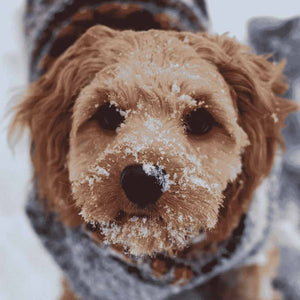Why you should keep your dog safe in winter
If you've had dry skin, cracked lips and red knuckles, you'll be well aware how the cold, dry, winter air plays havoc with your skin until the warm, moist air returns in the spring. But what about your dog?
Do dogs feel the cold in winter?
Despite their fur, it’s a common misconception that dogs don’t feel the cold the same as humans, so protecting them from extreme winter weather is essential. The RSPCA recommends that a dog’s environment should be at least 50ºF, so if the temperature drops below this, it’s time to take action.
How do you know if your dog is actually cold? It's not always obvious but here is a useful guide. Keeping them warm, protecting delicate paws and bringing them indoors are some basic essentials for keeping dogs safe and warm in snowy or icy conditions and during the inevitable rainy walks.
Pay attention to your dog's paws
A dog's pads are very important to him. In addition to providing tactile information and traction, they balance his weight evenly, and they serve as shock absorbers, saving wear and tear on joints and muscles. So it's important we keep an eye out for any issues.
Your dog's pads can become very dry in winter, one thing to look out for is increased paw-licking. That dryness leads to discomfort or pain. One way to prevent pads becoming too dry is to rub petroleum jelly on them before and after a walk.
When your dog returns from his walk when there is snow or ice on the ground, gently his legs and stomach, then rub his paws in a bowl or bucket of warm water to remove any road salt or grit. Check for any cuts and apply the petroleum jelly to add a layer of protection and prevent his paws from drying out indoors. We have the heating turned up in winter which dries the air.
Apply special dog paw cream or wax
Don't apply your own moisturizing cream as some brands contain ingredients that are toxic to dogs. You can apply pet-safe moisturizers to help keep the pads as supple as possible but keep in mind that your dog will want to lick it off so apply thoroughly.
There are also several brands of paw wax on the market. The wax is absorbed by the pads and generally won’t rub off onto carpets and furniture, and most waxes can be applied once a week unless your dog spends a great deal of time outdoors.
Consider some rubber booties in harsh conditions
The cold, wet ground following a rain or snow storm can be especially problematic. There was a time when the mere mention of booties for dogs brought eye rolls. But as their value has become more obvious, the booties have become more popular. Not all dogs will wear booties, but for those that will, the feet, especially the pads, will be nicely protected.
Keep paw hair trimmed
It’s helpful to keep the hair between the dog’s toes trimmed in winter. When walking, ice and snow can form balls between the toes, making it difficult and painful to walk, and rendering the area vulnerable to frostbite and cuts.
Keep protecting dogs from fleas and ticks
In a natural setting, fleas and ticks wouldn’t be a problem for your dog during the winter as they wouldn’t be able to survive the cold weather. A lot of dog owners will stop treating their dog for them throughout the winter because of this.
However, the majority of homes throughout the US will have central heating on, offering a prime breeding environment for such pests. This means it’s essential to continue to treat for fleas and ticks all year round as a preventative measure as they can cause irritation and illness for your dog.
Don’t leave dogs outside or in cars
Dogs that love to be outdoors in all weathers and have a kennel in the garden should still be brought inside when the weather gets really cold. The RSPCA in the UK for example often put out a “don’t forget your pets” warning to remind owners to bring all pets indoors for their safety.
Dogs should also never be left in cars in the winter, similar to hot weather in the summer, as the temperature can plummet quickly, and your dog will struggle to maintain their body temperature, which could lead to hypothermia.
Common questions about dog care in winter
Should I put clothes on my dog in winter?
Dogs can get cold in extreme weather. Clothing may seem like a novelty item but it can make a big difference to your dog’s warmth. Jumpers and other clothing for your dog will help to keep them warm on winter walks and waterproof coats can keep them dry, which further reduces the chances of them becoming cold.
Should I cut my dog's fur in winter?
Cutting a dog's fur in winter depends entirely on the breed and how they are naturally adapted to the cold. Some breeds with dense coats may benefit from a trim to prevent ice and dirt buildup but for breeds with natural coats that protect them from the cold, it is best to avoid excessive clipping, as their coat acts as an insulator. Consult a veterinarian or dog groomer if in doubt.
Can dogs sleep outside in winter?
As previously stated, it is not recommended that your dog be outside the home in extremely cold conditions, even though he may be used to it. It is important that your dog has a safe, dry place to sleep with an appropriate temperature so that he can maintain a healthy body temperature.
What about taking my dog to the beach in winter?
Most beaches allow you to walk your dog during the winter though regulations vary by location so be sure to check. It is important also to check the specific rules of the beach before taking your dog, respecting designated areas and picking up trash to maintain a clean and friendly environment for everyone.
Although coastal areas tend to have milder temperatures, prevent your dog from going in the sea if it is really cold. Damp and cold is a bad combination and can cause health problems for your dog.
You should also keep your dog away from any frozen water, such as rivers, ponds and lakes, as they can present a drowning risk and they shouldn’t swim in cold water either.
Dogs are beloved members of our family and keeping them warm on winter walks is an essential part of caring for them.
Main photo by Mia Anderson on Unsplash



